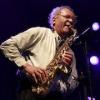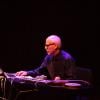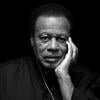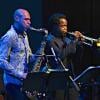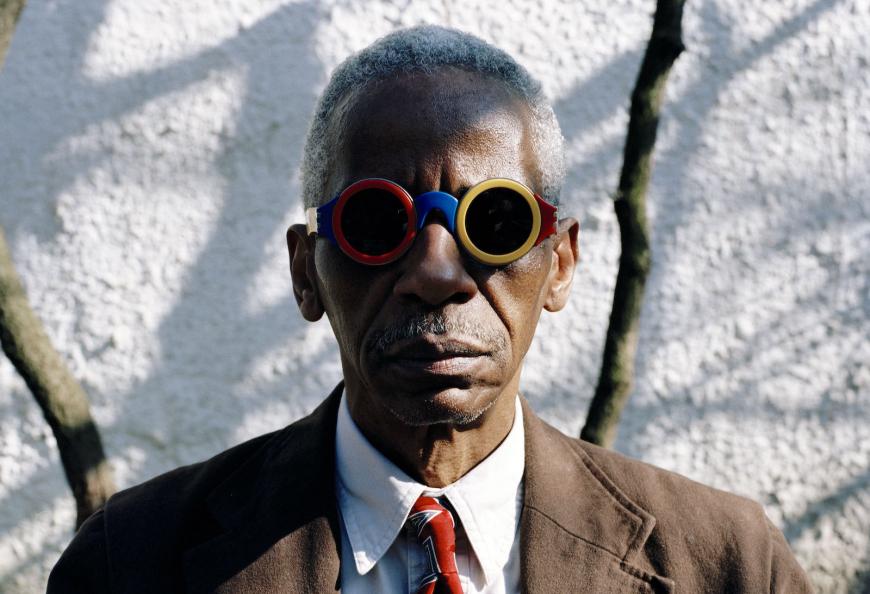
At age 81, Roscoe Mitchell still has audiences shaking their heads at the sounds he gets from his saxophones and other instruments. To say that Mitchell plays with “force” and “power” is an understatement. But Mitchell, who first made a name for himself in the mid-to-late 1960s with experimentation that helped broaden jazz’s repertory, has never had the extended volcanic gusto of, say, John Coltrane, whose music influenced Mitchell.
Instead, Mitchell’s music has always been about “location, location, location.” It’s where the notes fall on stage that matters, and how they overlap with parallel and competing notes. Loudness becomes secondary to Mitchell’s vision of songs that can circle around, hesitate, dart again, and then — elliptically — transition into something bigger.
That’s what happened on Thursday night at Mills College in Oakland, where Mitchell appeared onstage at Littlefield Concert Hall as part of a four-day event called, “Music in the Fault Zone: Experimental Music at Mills College, 1939–Present.” The night was bittersweet — not because Mitchell and the musicians who performed his music fell short, but because they played so well at a time when Mills College’s music program may change so irreparably that it’s only a music program in spirit rather than practice.
Mitchell taught regularly in that program for years, until 2019, and in the past year, as San Francisco Classical Voice has noted (see also here), Mills College has experienced financial belt-tightening and is now merging with Northeastern University. Northeastern already has a music program, and David Bernstein, who heads Mills’ music program, told me just before Thursday’s concert that, “It’s difficult to predict what the future holds” for that program at Mills, while adding, “There are indications that [Northeastern] understands the uniqueness and reputation of our music program worldwide.”
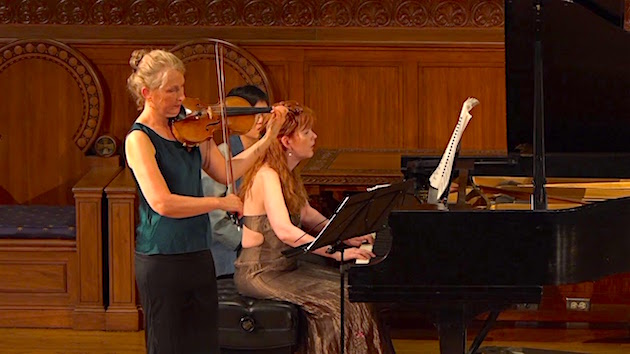
That uniqueness was on display from the first moments of Thursday night’s Roscoe Mitchell portion of the concert when violinist Kate Stenberg and pianist Sarah Cahill performed the world premiere of Mitchell’s Cards in 3D Colors for Violin and Piano. Commissioned by Stenberg and Cahill, the piece had them cascading through scales of dissonant notes as they answered each other and took the song through everything from heightened tensions to an occasional calmness that spoke to Mitchell’s penchant for incorporating minimalist expression in his long body of work. Cards in 3D Colors has its origins in the 1970s, when Mitchell created cards with musical notations that players in the Roscoe Mitchell Quartet could use to practice improvisation. He used the same cards in his Mills College classes from 2007 to 2019, when he helped a generation of musicians and music scholars understand experimentation and their own abilities to do what Mitchell himself does with seeming ease: seize the musical moment to say something new.
On Thursday night, after another world premiere of a Mitchell composition called Sustain and Run, which Mills College instructor Steed Cowart conducted with a full orchestra, the night’s coda arrived: Mitchell’s Distant Radio Transmission, a sonic spectacle of searing tonalities, eruptions, squeals, staccato, and ripples that, as its name implies, takes listeners to a place of otherworldliness. Almost 30 minutes long, Distant Radio Transmission featured Mitchell on soprano saxophone for a period of about five minutes, when he stood up from his seat to perform, but the piece was never intended to be solo focused.
Every orchestra musician onstage had an important role to play in carrying off Distant Radio Transmission, including James Fei, a composer and Mills College instructor who was the song’s “Live Electronics Solo Improviser” and played sounds that pushed the song to its outer limits, and baritone vocalist Thomas Buckner, whose garblings and warblings were like primal screams and the musical embodiment of “speaking in tongues.” It all perfectly synced, and it all begged the question: Should Mitchell really be thought of as a “jazz musician”?
Distant Radio Transmission, which Mitchell first premiered in 2017 at San Francisco’s de Young Museum to accompany an installation by visual artist Leonardo Drew, has elements of classical music and opera and can even be connected musically to such avant-garde rock songs as the Beatles’ Revolution 9. Yes, Distant Radio Transmission is relatively new to Mitchell’s repertory, but it feels like a clear outgrowth of Mitchell’s first album, Sound from 1966, which he recorded as the Roscoe Mitchell Sextet. On that album, a younger Mitchell does resemble Coltrane at times, but you can hear the same kind of intense, minimalist string-plucking that Stenberg did on Thursday night at Mills. And you can hear the same kind of depth and even whimsy that emerged throughout Thursday night’s performances.
Mitchell has had a storied career, which includes co-founding the Art Ensemble of Chicago in the 1960s. He continues to be in demand around the world. In the weeks before his Mills College concert, Mitchell was in Norway to headline the Borealis Festival for experimental music, where he played onstage alongside a giant recorded video of himself performing inside his Wisconsin home. It was vintage Mitchell. Occasionally in the film, Mitchell’s dog would howl with the music — adding an unexpected but surprisingly integrated element of sound. (Though May 1, you can watch the recorded Borealis concert for free at https://www.borealisfestival.no/en/online/.)
In June, Mitchell will perform in London, at Wigmore Hall, which usually features chamber music, and where he’ll also incorporate a video for the concert — an example, he told me in a phone interview, of his continuing quest to experiment with new projects, which has coincided lately with spending more time at home during the pandemic.
“A lot of things we do nowadays are in virtual time, so that’s how that came about,” he said from his Wisconsin house before flying to the Bay Area to rehearse for Thursday night’s program. “When I’m starting off a project, I have to take some ideas until I settle on one, and then the piece starts to talk back to me, and I’m fine and not worrying about anything.”
On Thursday night, Mitchell took several bows to acknowledge the audience’s applause, but he never took the microphone to talk about Mills’ transition from the college he knew it to be and his feelings about returning to a campus that was like a second home for him. If Mills’ music program does devolve into something that is less robust than a degreed program, Mitchell will have been one of its last big names, ending a long line that includes John Cage, Terry Riley, Pauline Oliveros, and Darius Milhaud (whose music was featured in the first portion of Thursday night’s concert at Littlefield Concert Hall). The uncertainty of Mills’ future, and the future of current faculty like Steed Cowart and James Fei, is unsettling to Mitchell. “The history of Mills is there,” he told me. “You’ve had so many great discoveries that happened along that way. … You’re not going to be able to replace these people.”
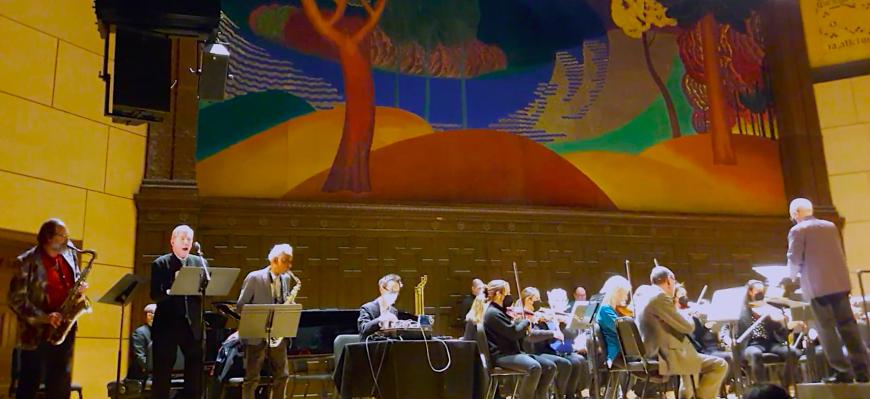
Still, he said, his world premieres and the performance of Distant Radio Transmission were not designed to bring attention to the uncertainties at Mills College and its storied music program. “No,” he said, “it’s about the music. … I’m coming back to celebrate Mills’ [music program] and to take part in this great concert.”
Thursday night’s performances were, indeed, “great.” But that word doesn’t begin to express what happened inside a Baroque concert hall on a campus tucked into Oakland’s foothills. When the last sounds of Distant Radio Transmission reverberated to the hall’s ceiling, and the applause had finished, a bevy of friends surrounded Mitchell onstage to congratulate him. It was a homecoming.
He often performs in a suit jacket, as he did on Thursday night. Mitchell’s formal dress can seem counterintuitive with the experimental music that is his forte, but external surfaces are merged with internal doings in his practice. As he said in a June 2019 performance at Washington, D.C.’s Hirshhorn Museum that I attended, ”I practice inside and outside the chromatic scale. … I’m trying to get under the surface of the sound and then things really reveal themselves.”
That’s why Mitchell’s music will always feel timeless: His music is internalized expression sent to the surface for people to feel viscerally. Mitchell himself never has to say a word when he performs. He lets his music do the talking. And what it says is always noteworthy and thought-provoking, however people want to label it.


